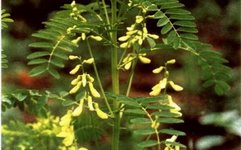This product is the dried root of the leguminous plant Mongolian Huangqi (Astragalus membranaceus (Fisch.) Bge. var. mongholicus (Bge.) Hsiao) or Membranous Huangqi (Astragalus membranaceus (Fisch.) Bge.). It is harvested in spring and autumn, with the fibrous roots and root tips removed and then dried in the sun.
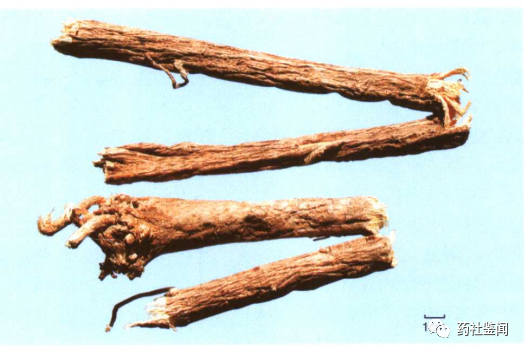
【Properties】 This product is cylindrical, sometimes branched, with a thicker upper end, measuring 30-90 cm in length and 1-3.5 cm in diameter. The surface is light brown or light brownish-yellow, with irregular longitudinal wrinkles or grooves. It is hard and tough, not easily broken, with a fibrous and powdery fracture surface; the bark is yellowish-white, and the wood part is light yellow with radial textures and cracks. The center of old roots may appear decayed, blackish-brown, or hollow. It has a faint aroma and a slightly sweet taste, with a slight bean-like flavor when chewed.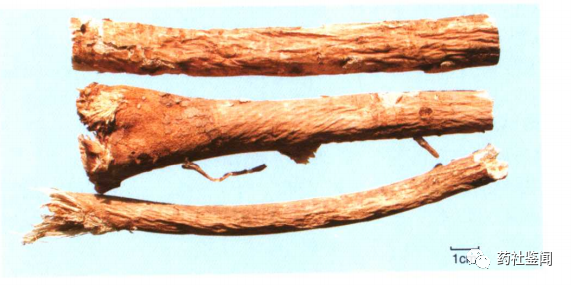
【Identification】 (1) Cross-section: The cork cells are in multiple rows; the inner cork layer consists of 3-5 rows of thick-walled cells. The outer side of the phloem rays is often curved, with cracks; fibers are bundled, thick-walled, lignified or slightly lignified, interspersed with sieve tube groups; stone cells may sometimes be seen near the inner cork layer. The cambium forms a ring. The xylem vessels are scattered singly or in groups of 2-3; there are wood fibers between the vessels; sometimes single or groups of 2-4 stone cells can be seen in the rays. Parenchyma cells contain starch granules. The powder is yellowish-white. Fibers are bundled or scattered, with a diameter of 8-30 μm, thick-walled, with longitudinal cracks on the surface; the primary wall often separates from the secondary wall, and the ends often break into root-like shapes or are cut flat. The vessels with bordered pits are colorless or orange-yellow, with closely arranged bordered pits. Stone cells are rare, round, oval, or irregularly shaped, with thick walls. (2) Thin-layer chromatography (General Rule 0502) test: Take 5-10 μl of the test solution and control solution under [Content Determination], respectively, and spot them on the same silica gel G thin-layer plate. Use the lower layer solution of chloroform-methanol-water (13:7:2) as the developing agent, develop, remove, dry, and spray with 10% ethanol sulfuric acid solution, heat at 105°C until the spots are clearly colored, and examine under sunlight and ultraviolet light (365 nm). In the test chromatogram, at the corresponding position of the control chromatogram, a similar brown spot appears under sunlight; under ultraviolet light (365 nm), a similar orange-yellow fluorescent spot appears. (3) Take 2 g of the powdered product, add 30 ml of ethanol, and reflux for 20 minutes, filter, evaporate the filtrate, dissolve the residue in 15 ml of 0.3% sodium hydroxide solution, filter, adjust the pH of the filtrate to 5-6 with dilute hydrochloric acid, extract with 15 ml of ethyl acetate, separate the ethyl acetate solution, filter through filter paper with an appropriate amount of anhydrous sodium sulfate, and evaporate the filtrate. Dissolve the residue in 1 ml of ethyl acetate to prepare the test solution. Take 2 g of Huangqi control material and prepare the control solution in the same manner. Perform thin-layer chromatography (General Rule 0502) test, taking 10 μl of each solution and spotting them on the same silica gel G thin-layer plate, using chloroform-methanol (10:1) as the developing agent, develop, remove, dry, and expose to ammonia vapor, then examine under ultraviolet light (365 nm). In the test chromatogram, at the corresponding position of the control material chromatogram, the same colored fluorescent main spots appear. 【Examination】 Moisture must not exceed 10.0% (General Rule 0832, Method 2). Total ash must not exceed 5.0% (General Rule 2302). Heavy metals and harmful elements are determined according to the methods for lead, cadmium, arsenic, mercury, and copper (General Rule 2321, atomic absorption spectrophotometry or inductively coupled plasma mass spectrometry). Lead must not exceed 5 mg/kg; cadmium must not exceed 1 mg/kg; arsenic must not exceed 2 mg/kg; mercury must not exceed 0.2 mg/kg; copper must not exceed 20 mg/kg. Residual organic chlorine pesticides are determined according to the pesticide residue determination method (General Rule 2341, organic chlorine pesticide residue determination method - Method 1). Pentachloronitrobenzene must not exceed 0.1 mg/kg. 【Extractives】 According to the water-soluble extractive determination method (General Rule 2201) under cold soaking, it must not be less than 17.0%. 【Content Determination】 Astragaloside is determined by high-performance liquid chromatography (General Rule 0512). Chromatographic conditions and system suitability test: Use octadecylsilyl-bonded silica gel as the stationary phase; acetonitrile-water (32:68) as the mobile phase; and evaporative light scattering detection. Theoretical plate number for the Astragaloside peak should not be less than 4000. Preparation of the control solution: Take an appropriate amount of Astragaloside reference substance, accurately weigh, and dissolve in 80% methanol to prepare a solution containing 0.5 mg per 1 ml. Preparation of the test solution: Take about 1 g of the powdered product (passed through a No. 4 sieve), accurately weigh, place in a stoppered conical flask, and accurately add 50 ml of 80% methanol solution containing 4% concentrated ammonia solution (take 4 ml of concentrated ammonia solution and add 80% methanol to 100 ml, shake well). Seal tightly, weigh, reflux for 1 hour, cool, and reweigh. Use 80% methanol solution containing 4% concentrated ammonia to make up for the weight loss, shake well, filter, accurately measure 25 ml of the filtrate, evaporate to dryness, dissolve the residue in 80% methanol, transfer to a 5 ml volumetric flask, and add 80% methanol to the mark, shake well, and filter to obtain the final filtrate. Determination method: Accurately take 2 μl (or 5 μl) of the control solution and 10-20 μl of the test solution, inject into the liquid chromatography system for measurement, and calculate using the external standard two-point logarithmic equation. The product must contain not less than 0.080% Astragaloside (C41H68O14) based on the dried product. The content of Isoflavonoid Glycosides is determined by high-performance liquid chromatography (General Rule 0512). Chromatographic conditions and system suitability test: Use octadecylsilyl-bonded silica gel as the stationary phase; acetonitrile as mobile phase A, and 0.2% formic acid solution as mobile phase B, performing gradient elution according to the specified table; detection wavelength is 260 nm. The theoretical plate number for the Isoflavonoid Glycosides peak should not be less than 3000. Preparation of the control solution: Take an appropriate amount of Isoflavonoid Glycosides reference substance, accurately weigh, and dissolve in methanol to prepare a solution containing 50 μg per 1 ml. Preparation of the test solution: Take about 1 g of the powdered product (passed through a No. 4 sieve), accurately weigh, place in a round-bottom flask, and accurately add 50 ml of methanol, weigh, reflux for 4 hours, cool, and reweigh. Use methanol to make up for the weight loss, shake well, filter, accurately measure 25 ml of the filtrate, recover the solvent to dryness, dissolve the residue in methanol, transfer to a 5 ml volumetric flask, and add methanol to the mark, shake well, and filter to obtain the final filtrate. Determination method: Accurately take 10 μl of both the control solution and the test solution, inject into the liquid chromatography system for measurement. The product must contain not less than 0.020% Isoflavonoid Glycosides (C22H22O10) based on the dried product. The processed slices should remove impurities, separate by size, wash clean, soak thoroughly, cut into thick slices, and dry. 【Properties】 This product appears as thick slices that are round or oval in shape, with an outer skin that is yellowish-white to light brown, showing longitudinal wrinkles or grooves. The cut surface shows a yellowish-white bark and light yellow wood, with radial textures and cracks, and sometimes the center appears decayed, blackish-brown, or hollow. It has a faint aroma and a slightly sweet taste, with a slight bean-like flavor when chewed.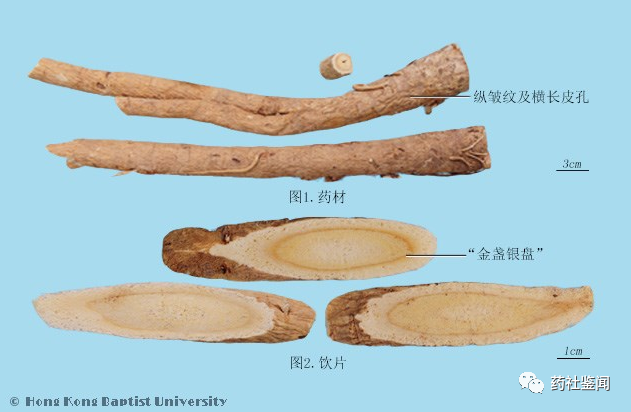
【Identification】 (except for cross-section) 【Examination】 【Extractives】 【Content Determination】 same as the medicinal material. 【Taste and Meridian Entry】 Sweet, slightly warm. Enters the Lung and Spleen meridians. 【Functions and Indications】 Tonifies Qi and raises Yang, stabilizes the exterior and stops sweating, promotes urination and reduces swelling, generates fluids and nourishes blood, moves stagnation and alleviates pain, expels toxins and promotes suppuration, and promotes wound healing. Used for Qi deficiency and fatigue, poor appetite and loose stools, prolapse of the middle Qi, chronic diarrhea and rectal prolapse, blood in stools and uterine bleeding, spontaneous sweating due to exterior deficiency, Qi deficiency with edema, internal heat with thirst, blood deficiency with sallow complexion, hemiplegia, numbness and pain, difficult-to-heal carbuncles, and chronic ulcers that do not heal. 【Dosage and Administration】 9-30 g. 【Storage】 Store in a ventilated, dry place, protect from moisture and pests.3. Authenticity Identification
1. Mongolian Huangqi (Pharmacopoeia Product) The medicinal material is the dried root of the leguminous plant Mongolian Huangqi (Astragalus membranaceus (Fisch.) Bunge var. mongholicus (Bge.) Hsiao). This product is long cylindrical, straight, with few branches, thicker at the upper end, and if the root tip is not removed, the stem base remains more, measuring 40-90 cm in total length and 1.2-3.5 cm in diameter. The surface is light yellow to brownish-yellow, slightly rough, with obvious longitudinal wrinkles and transverse long lenticels, hard and tough, not easily broken, with a fibrous and powdery fracture surface; the bark is light yellow, and the wood part is light yellow with regular radial textures and cracks; the center of old roots is often decayed or hollow, brownish. It has a faint aroma, sweet taste, and a slight bean-like flavor when chewed.
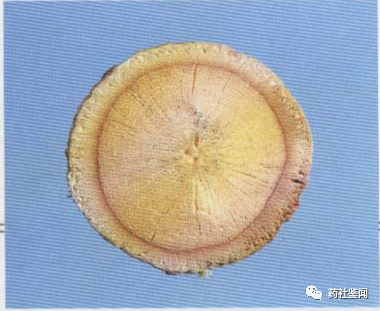
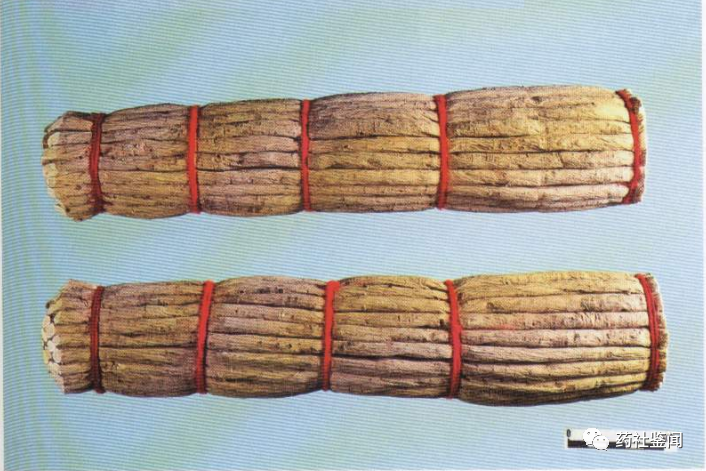

2. Membranous Huangqi (Pharmacopoeia Product)
The medicinal material is the dried root of the leguminous plant Membranous Huangqi (Astragalus membranaceus (Fisch.)). This product is similar to the root of Mongolian Huangqi, but the surface is generally brownish to blackish-brown. If the root tip is not removed, the stem base is slightly less, and the main stem base is obvious, with a slightly harder texture.
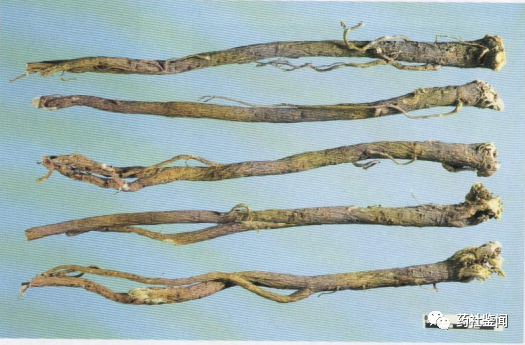
3. Non-authentic Product: Spindle Fruit Huangqi
It is the dried root of the leguminous plant Spindle Fruit Huangqi (Astragalus ernestii Comb.). This product is cylindrical, straight, with few branches. The surface is dark brown to brownish-yellow, with fewer wrinkles, and the outer skin is easy to peel off, with a loose and pliable texture, fibrous fracture surface, light yellow wood part, and yellowish-white bark, which separates easily from the wood part. It has a bean-like flavor.
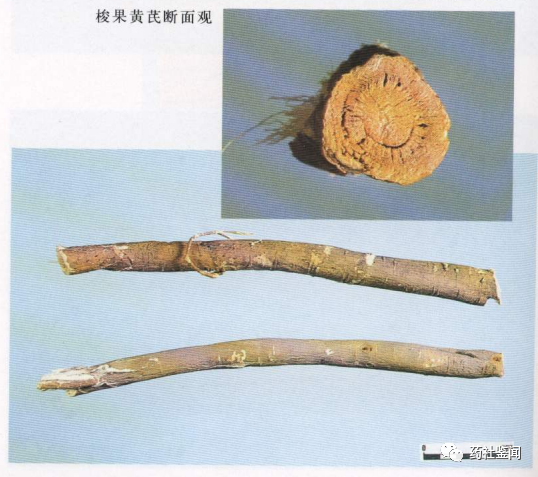
4. Non-authentic Product: Multi-flowered Huangqi
It is the dried root of the leguminous plant Multi-flowered Huangqi (Astragalus floridus Benth. ex. Bge.). This product is long cylindrical, often twisted, with the upper end often appearing decayed. It measures 40-100 cm in length and 1-3.5 cm in diameter. The surface is brownish-yellow to brownish, with obvious longitudinal wrinkles. It is hard and tough, with a fibrous fracture surface, weak powdery texture, and the bark occupies only about 1/3 of the radius. It has a faint aroma, a mild taste, and a slightly bitter outer skin.
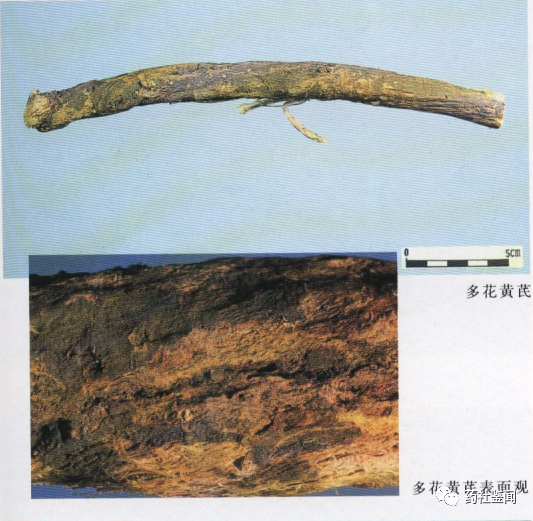
5. Non-authentic Product: Dong E Luo Huangqi
It is the dried root of the leguminous plant Dong E Luo Huangqi (Astragalus tongolensis Ulbr.). This product is long conical, with few branches, and the center is loose or hollow. It measures 20-50 cm in length and 1.0-2.5 cm in diameter. The surface is light yellow to deep yellow, often showing traces of fibrous roots and protrusions. It has a loose texture, pliable, not easily broken, with a weak fibrous fracture surface, and the bark occupies about half of the radius. It has a sweet taste and a bean-like aroma.
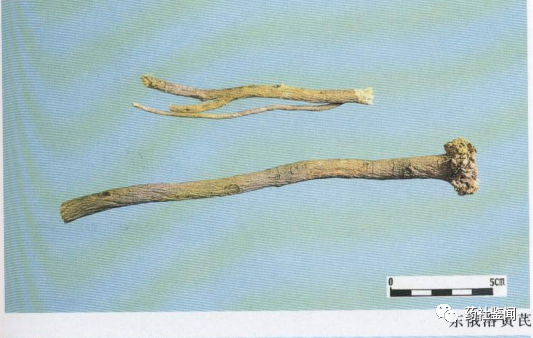
6. Non-authentic Product: Golden Wing Huangqi
It is the dried root of the leguminous plant Golden Wing Huangqi (Astragalus chrysopterus Bge.). This product is long cylindrical, with the main root often bifurcated. It measures 30-100 cm in length and 0.8-1.5 cm in diameter. The surface is light yellow to dark brown, with fine ring patterns visible at the upper part, and obvious longitudinal wrinkles. It is dense, tough, with a fibrous fracture surface, and rich in powdery texture, with the bark occupying about half of the radius. It has a sweet taste and a strong bean-like aroma.
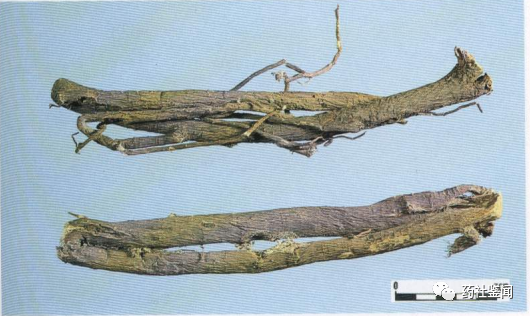
7. Non-authentic Product: Single Stamen Huangqi
It is the dried root of the leguminous plant Single Stamen Huangqi (Astragalus monodelphus Bge.). This product is similar to Golden Wing Huangqi, but the root tip has no major lateral roots, and the center is loose or hollow, pliable. It has a sweet taste and a strong bean-like flavor.
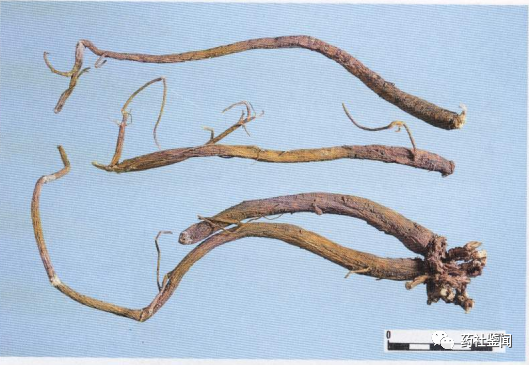
8. Non-authentic Product: Sichuan Huangqi
It is the dried root of the leguminous plant Sichuan Huangqi (Astragalus sutchuenensis Franch.). This product is long slender conical. The surface is grayish-brown, with obvious transverse wrinkles at the upper part of the root. It is light in weight, with a fibrous fracture surface.
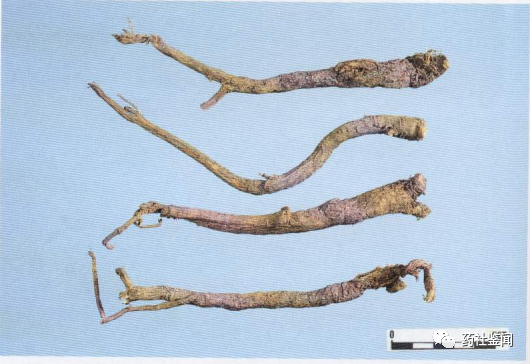
9. Non-authentic Product: Round-leaf Malva
It is the dried root of the Malvaceae plant Round-leaf Malva (Malva rotundifolia L.). This product is long cylindrical, with a thicker root tip, having several residual stem bases, tapering downwards, with branches. The surface is yellowish-brown to earthy yellow, with fine longitudinal wrinkles and transverse linear lenticels. It is hard and brittle, easily broken, with a pale yellow-brown bark and yellow wood, with a sweet taste and sticky texture, without a bean-like flavor.
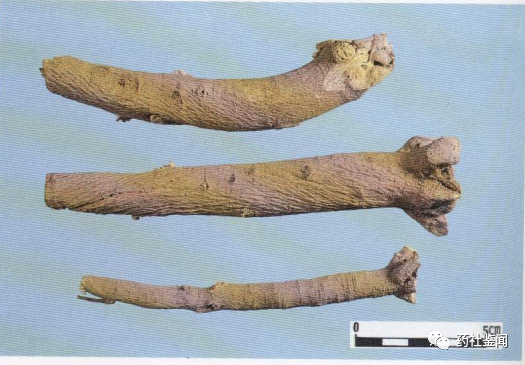
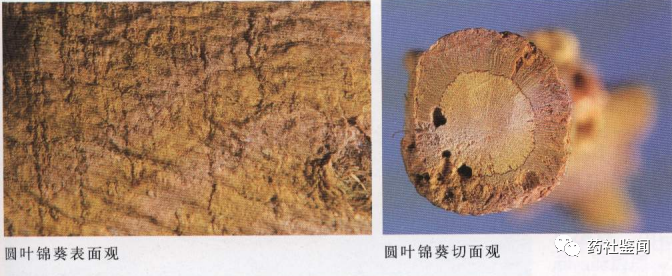
10. Non-authentic Product: European Marshmallow
It is the dried root of the Malvaceae plant European Marshmallow (Althaea officinalis L.). This product is long cylindrical, with a thick root tip, often having many above-ground residual stems, lateral roots, and supporting roots. It is light in weight, easily broken, with a weak fibrous fracture surface. It has a mild taste, with no bean-like flavor.
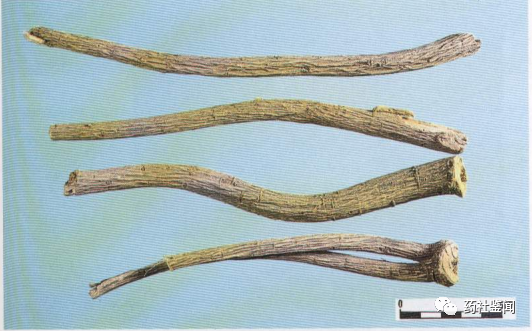
11. Non-authentic Product: Hollyhock
It is the dried root of the Malvaceae plant Hollyhock (Althaea rosea (L.) Cavan.). This product is cylindrical, with a larger upper end, having residual stem bases at the root tip, tapering downwards, with fine lateral roots. The surface is earthy yellow to brownish-yellow, with fine longitudinal wrinkles and obvious transverse linear lenticels. It is hard and brittle, with a yellow-white fracture surface, mild taste, and no bean-like flavor.
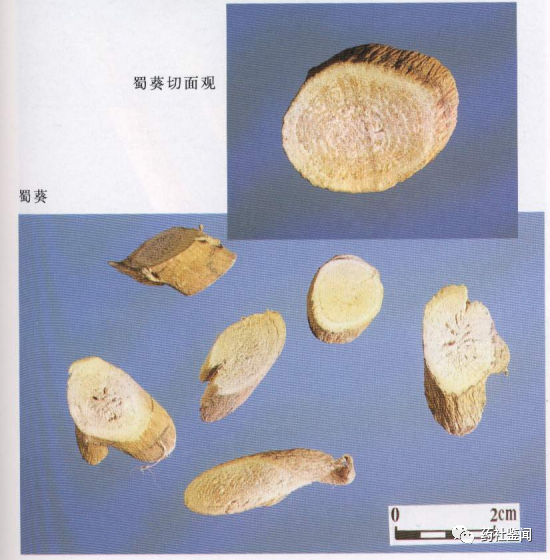
12. Non-authentic Product: Purple Alfalfa
It is the dried root of the leguminous plant Purple Alfalfa (Medicago sativa L.). This product is long cylindrical, measuring 20-35 cm in length and 0.5-2 cm in diameter. The root tip is thicker, sometimes with stem remnants, tapering downwards, often with branches. The surface is grayish-brown to reddish-brown. It is hard and brittle, easily broken, with an uneven fracture surface, yellow-white, and the bark is narrow, occupying more than 1/5 of the diameter. It has a weak aroma, slightly bitter taste, and a mild stimulating flavor.

13. Non-authentic Product: Caragana
It is the dried root of the leguminous plant Caragana (Caragana sinica (Bunchoz) Rehder). This product is cylindrical, measuring 12-20 cm in length and 1-1.5 cm in diameter. The surface is brown, with longitudinal wrinkles and sparse irregular transverse lenticels. If the cork is removed, the surface is light yellow, with residual transverse lenticels being brown. It is hard and brittle, with a fibrous fracture surface, pale yellow bark, and light yellow wood. It has a faint aroma and a mild taste.
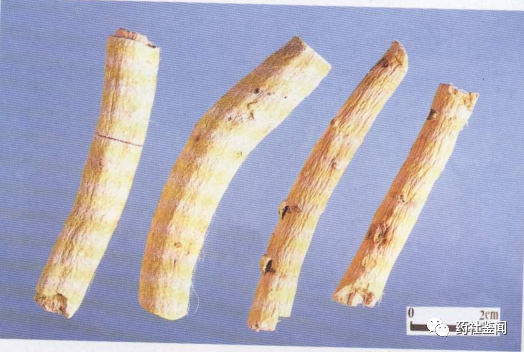
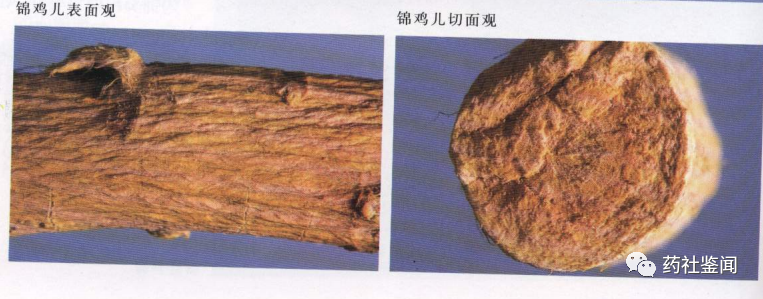
14. Non-authentic Product: Spiny Licorice
It is the dried root and rhizome of the leguminous plant Spiny Licorice (Glycyrrhiza pallidiflora Maxim.). This product has a cylindrical rhizome, measuring 16-25 cm in length and 0.3-1.5 cm in diameter. The surface is grayish-brown, with longitudinal wrinkles and transverse lenticels; the transverse section shows grayish-white bark and light yellow wood, occupying about 3/5 of the radius, with a small pith in the center. It is hard, with a weak aroma and a bitter taste. The roots are thinner, without pith, and the rest is similar to the rhizome.

15. Non-authentic Product: Blue Flower Pea
It is the dried root of the leguminous plant Blue Flower Pea (Oxytropis coerulea (Pall.) DC.). This product has a cylindrical root, with a thick root tip, having 5-20 secondary branches of above-ground residual stems. It measures 10-30 cm in length. The surface is brownish-yellow, with longitudinal wrinkles, and the cork is easy to peel off. It is light and soft, difficult to break, with a white fracture surface, and extremely fibrous yellow wood. It has a faint aroma and a mild taste.
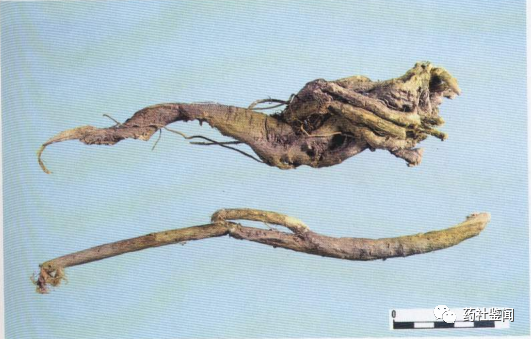
4. Huangqi Product Specifications and Grades
1. Huangqi ASTRAGALI RADIX is the dried root of the leguminous plant Mongolian Huangqi (Astragalus membranaceus (Fisch.) Bge. var. mongholicus (Bge.) Hsiao) or Membranous Huangqi (Astragalus membranaceus (Fisch.) Bge.). It is harvested in spring and autumn, with the fibrous roots and root tips removed and then dried in the sun.
2. Specification: Huangqi medicinal material is used to distinguish different trading categories during circulation. Note: According to different cultivation methods, Huangqi medicinal material is divided into transplanted Huangqi and wild-simulated Huangqi.
3. Grade: Under each specification of Huangqi medicinal material, it is used to distinguish the trading varieties of Huangqi quality. Note: Under each specification, the grades of Huangqi medicinal material are classified based on length and diameter at 3.5 cm below the cut end.
4. Transplanted Huangqi cultivated ASTRAGALI RADIX is cultivated by seedling for one year, transplanted for 1-2 years, with a total growth period of 2-3 years from seedling to harvest.
5. Wild-simulated Huangqi is cultivated using an artificial wild-simulated model for seed broadcasting growth, usually over 5 years, with characteristics similar to wild Huangqi.
6. Diameter at 3.5 cm below the cut end: the diameter at the point where the Huangqi medicinal material is cut and the hollow area is greater than 1/3, measured at 3.5 cm below the cut end.
7. Specification grade classification should meet the requirements of Table 1, and the characteristic images are referenced in Appendix A.

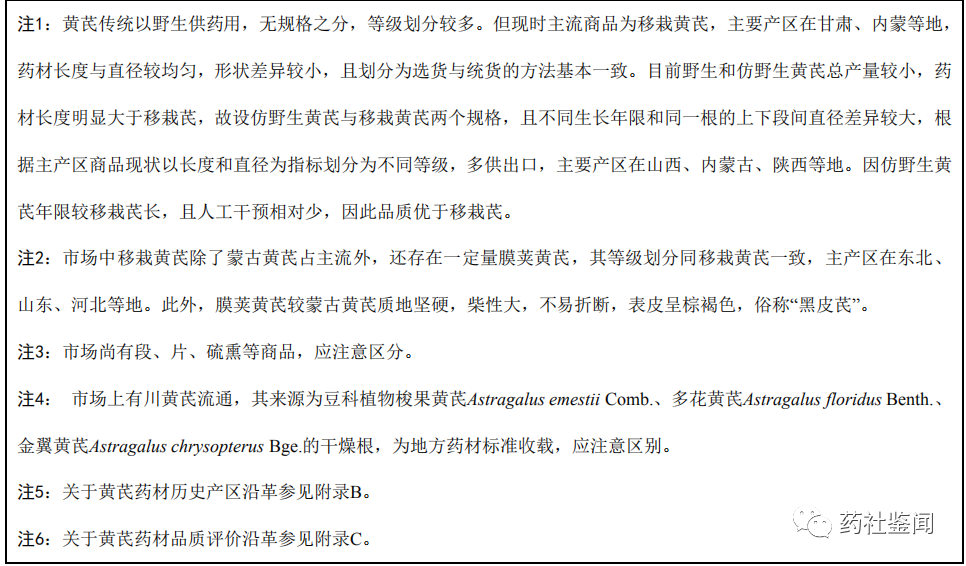
8. Requirements: In addition to complying with the provisions of T/CACM 1021.1-2016, it should also meet the following requirements:
—— No fibrous roots;
—— No insect damage;
—— No mold;
—— Impurities less than 3%.
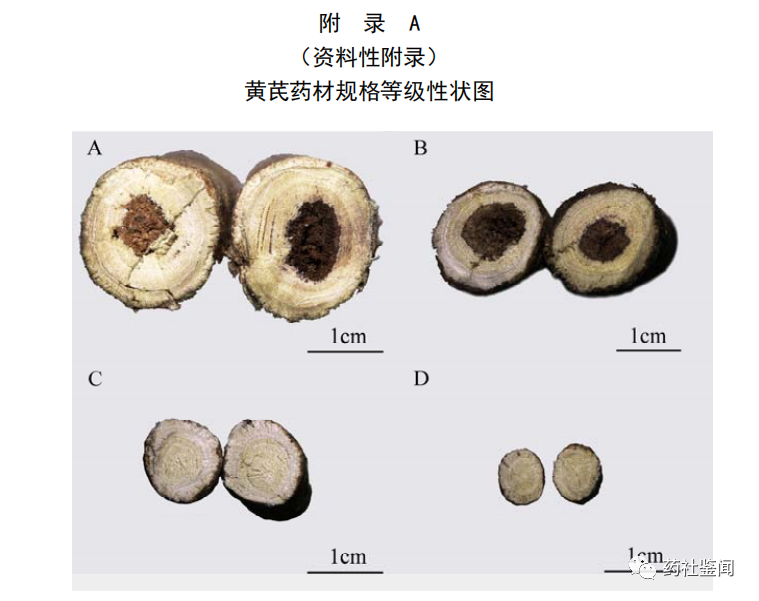
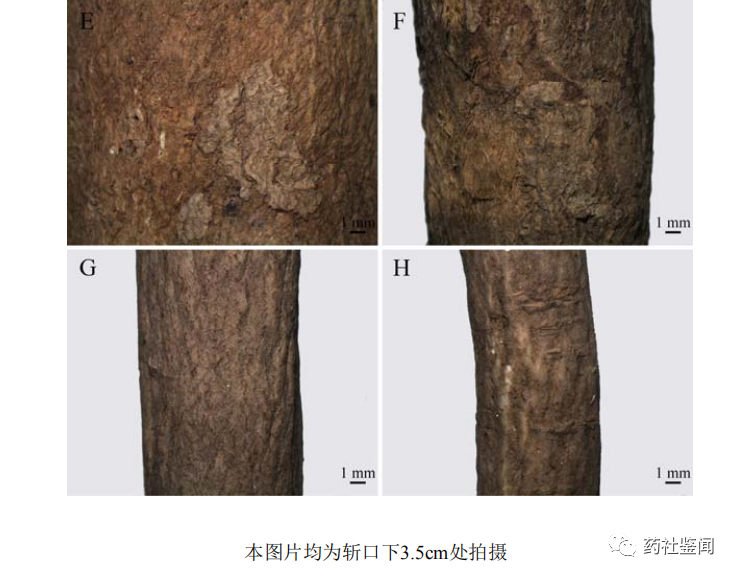
Explanation:A—— First-class wild-simulated Huangqi cross-section view;
B—— Second-class wild-simulated Huangqi cross-section view;
C—— Third-class wild-simulated Huangqi cross-section view;
D—— Fourth-class wild-simulated Huangqi cross-section view;
E—— First-class wild-simulated Huangqi surface view;
F—— Second-class wild-simulated Huangqi surface view;
G—— Third-class wild-simulated Huangqi surface view;
H—— Fourth-class wild-simulated Huangqi surface view.


Figure A.3 Transplanted Huangqi Specification Grade Characteristic Image
Explanation:
A—— General quality transplanted Huangqi whole medicinal material;
B—— Selected quality transplanted Huangqi whole medicinal material;
C—— General quality transplanted Huangqi cross-section view (3.5 cm below the cut end);
D—— Selected quality transplanted Huangqi cross-section view (3.5 cm below the cut end);
E—— General quality transplanted Huangqi surface view (3.5 cm below the cut end);
F—— Selected quality transplanted Huangqi surface view (3.5 cm below the cut end).
5. Historical Production Areas of Huangqi Medicinal Material
Huangqi, also known as Huangqi, was first recorded in the “Shennong Bencao Jing” as a top-grade herb. During the Wei and Jin dynasties, the production areas of Huangqi were clearly documented, as noted in the “Ming Yi Bie Lu”: “Grows in Shuzhou (around Zitong and Chengdu in Sichuan), Bai Shui (near Songpan or Biko in Sichuan), and Hanzhong (Nanzheng in Shaanxi).” In the Liang dynasty, Tao Hongjing wrote in the “Bencao Jing Jizhu”: “First produced in Longxi (southeast Gansu), Taoyang (Lintan, Gansu)… followed by Heishui (northern Sichuan, Heishui County), Dang County (Gansu)… and also in Canling (northern Sichuan) and Bai Shui.” This indicates that during this period, the main production areas of Huangqi were in Sichuan, Gansu, and the border of Shaanxi, with Sichuan being predominant.
During the Southern and Northern Dynasties, the production areas of Huangqi began to expand northward, with new additions in Longxi, Taoyang, and Dangchang. In the Sui and Tang dynasties, the “Newly Compiled Materia Medica” recorded: “Now produced in Yuanzhou (now Guyuan City, Ningxia) and Huayuan (now Yaozhou District, Tongchuan City, Shaanxi) is the best, while Shuhan (referring to Shuzhou and Hanzhong) is no longer used. Yizhou (Maozhou, Sichuan) and Ningzhou (now Ning County, Qingyang, Gansu) are also good.” The “Four Sounds Materia Medica” states: “Produced in Yuanzhou, Huayuan, Guzi Mountain, and has yellow flowers.” The “Discussion on Medicinal Properties” states: “Grows in Longxi (now within Longxi, Gansu), tonifying the five organs. The Shuzhou Bai Shui red skin is slightly cold.” This shows that during the Sui and Tang dynasties, the production areas of Huangqi further changed, expanding from the central and southern regions of Gansu to the adjacent Ningxia Guyuan and Shaanxi Tongchuan.
In the Song dynasty, the production areas of Huangqi expanded eastward based on previous dynasties, adding areas in Hedong and Shaanxi. The “Jiayou Bencao” states: “Now Yuanzhou is good, Yizhou (Maozhou, Sichuan) and Ningzhou (now Ning County, Qingyang, Gansu) are also good.” The “Tu Jing Bencao” states: “Now Hedong (most of Shanxi) and Shaanxi (most of Shaanxi) have many.” In the Jin and Yuan dynasties, the “Tang Ye Bencao” states: “Grows in Shuzhou mountains and valleys, Bai Shui, Hanzhong, and now many in Hedong and Shaanxi.” The current “Bencao Tujing” only mentions Hedong, which refers to Qinzhu Mianshang, hence called Mianqi. It tastes sweet as honey, and its body is soft like cotton, which is considered as cotton, but it is not. It is said that Huangqi originally comes from Mianshang, hence the “Tu Jing” depicts it as Xianshui, which is adjacent to Mianshang, indicating that the place of origin is referred to as ‘cotton’. If softness is referred to as ‘cotton’, then the counterfeit ones are also soft. But it is only distinguished by being crisp and sweet and bitter.
In the Ming dynasty, there were no new production areas for Huangqi. The “Bencao Pinhui Jingyao” summarized all previous historical descriptions of Huangqi’s production areas, inheriting the previous dynasties’ understanding of the production areas. The “Bencao Pinhui Jingyao” states: “The ‘Tu Jing’ says Huangqi grows in Bai Shui, Chi Shui, both belong to Longxi. Bai Shui is superior, this is a medium product. Mianqi comes from Shanxi Qinzhu (now Qinyuan County, Shanxi) Mianshang, where the township name has a patrol office. This product is excellent, this is a top product.”
In the Qing dynasty, it continued the Ming dynasty’s tradition, praising the western-produced Mianqi as the best, and based on this, it continued to expand northward, resulting in new production areas in Inner Mongolia, which were considered the best. Some areas of Shanxi border Inner Mongolia, and the ecological environment is also similar, thus the characteristics and efficacy are similar. The “Bencao Chongyuan” states: “Huangqi grows in the northwest, with those from Shanxi Mianshang being the best… thus the world calls it Mian Huang.” The “Yilin Zuan Yao Tan Yuan” states: “Those from Mianshang are the best, now in Fenzhou Jiexiu.” The “Bencao Qiuzhen” states: “Those from Shanxi Licheng (a county under Changzhi City, Shanxi).” The “Yao Long Xiaopin” states: “Western products are the best.” The “Bencao Shou Gou Yuan” states: “Originally from Shuzhou, Hanzhong, now only Bai Shui, Yuanzhou, Huayuan mountain valleys are the most superior. Yizhou and Ningzhou are also good.” Wu Qizhun’s “Plant Names and Facts” states: “There are several types, those from Shanxi and Mongolia are the best, while those from Yunnan are purgative and not used.” The “Plant Names and Facts” first mentioned “Mongolian” Huangqi and believed that “Shanxi and Mongolia” Huangqi quality is good, providing a basis for later generations to regard Shanxi and Inner Mongolia Huangqi as authentic medicinal materials.
In the Republic of China period, the production areas of Huangqi expanded northeastward to the three northeastern provinces, resulting in multiple regions of Huangqi, such as Northeast Huangqi (Zhengqi), Shanxi Mianqi, Chuanqi, and Yuzhouqi, with the newly added northeastern production areas being considered authentic Huangqi due to fertile soil and other factors.
In contemporary times, with the significant increase in the use of Huangqi, wild medicinal materials can no longer meet the actual needs. Therefore, cultivation began in the 1960s-70s, gradually becoming the main source. Currently, Huangqi cultivation is divided into transplanted Huangqi and wild-simulated Huangqi. The mainstream area for transplanted Huangqi cultivation is Gansu and Inner Mongolia; the mainstream area for wild-simulated Huangqi cultivation is Shanxi (Hunyuan and surrounding counties), Shaanxi (Zizhou County), and Inner Mongolia (Wuchuan County). Due to the long growth period, the individual medicinal materials are significantly larger than transplanted Huangqi, and the total yield is also far lower than transplanted Huangqi.
6. Evolution of Huangqi Medicinal Material Quality Evaluation
During the Southern and Northern Dynasties, the production areas of Huangqi began to expand northward, with new additions in Longxi, Taoyang, and Dangchang, while the understanding of Huangqi quality significantly improved compared to previous dynasties, such as “First produced in Longxi, Taoyang, yellowish-white, sweet.” Evaluating the quality of different production areas based on external characteristics, color, and taste can be considered the earliest record of authentic medicinal material quality evaluation methods. In the Song dynasty, the “Bencao Bieshu” states: “Huangqi is best from Mianshang, hence named Mian Huangqi. The current ‘Tu Jing’ depicts Xianshui as Mianshang, which is adjacent. It is said to be soft and pliable like cotton, hence called Mian Huangqi. However, Huangqi is originally soft and pliable, while counterfeit ones are only distinguished by being crisp.” The “Zhong Guang Bu Zhu Shen Nong Ben Cao Bing Tu Jing” states: “Huangqi originally comes from Mianshang (now southeast of Jiexiu, Shanxi) as the best, hence named Mian Huangqi. The current ‘Tu Jing’ depicts Xianshui (now parts of Loufan County and Jingle County in Shanxi) as Mianshang, which is adjacent.” In the Song dynasty, the quality of Mian Huangqi from Shanxi was first proposed as the best, and Shanxi Mian Huangqi has been revered by later generations, influencing until today. Wang Haogu from the Jin and Yuan dynasties provided a detailed explanation of Shanxi Mian Huangqi, believing it was named after its origin, not its characteristics, as non-local ones are also soft. He also recognized that Mian Huangqi tastes sweet as honey and has a body soft like cotton, further reinforcing the quality of Mian Huangqi, which has been recognized by later generations.
In the Ming dynasty, the “Bencao” regarding Huangqi’s authentic production areas had a notable characteristic of consistently considering Huangqi from Mianshang as the best. By this time, the authentic production area of Huangqi was stabilized in Shanxi. The “Bencao Meng Quan” states: “Shuiqi grows in Bai Shui and Chi Shui, both belong to Longxi. Bai Shui is superior, this is a medium product. Mianqi comes from Shanxi Qinzhu (now Qinyuan County, Shanxi) Mianshang, where the township name has a patrol office. This product is excellent, this is a top product.”
In the Republic of China period, the emergence of imitative Huangqi, that is, the high-quality ones among the冲口芪 were first made into powdered Huangqi or Mian Huangqi, while those of slightly lower quality were dyed black, becoming the冲口芪, and the remaining raw Huangqi became Hunchunqi and Niuzhuangqi; in addition, a transit trade center formed in Yuzhou. Yuzhouqi is actually produced outside the ancient Beikou (now most of Zhangjiakou and Chengde in Hebei and parts of Inner Mongolia). This period greatly enriched the understanding of production areas, while also clarifying the scientific connotation and quality evaluation of the authenticity of Huangqi from different production areas (bean-like aroma, sweetness, and quality relationship).
In summary, the quality evaluation of production areas indicates that Huangqi is mainly good from Shanxi, Gansu, and Inner Mongolia. Gansu mainly cultivates transplanted Huangqi, while the production areas of wild-simulated Huangqi are mainly in Shanxi and Shaanxi, with better quality than transplanted Huangqi. The quality evaluation of characteristics considers yellowish-white color, pliability, and sweet taste as the best. The formulation of Huangqi product specification grade standards this time is based on modern literature on Huangqi medicinal material quality evaluation and market survey situations, according to the above two specifications, and then graded based on the appearance and texture of the medicinal material combined with length and diameter.

